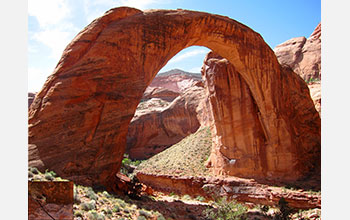Multimedia Gallery
Utah's Rainbow Bridge in Rainbow Bridge National Monument
Utah's Rainbow Bridge in Rainbow Bridge National Monument, Utah, is one of the world’s largest natural arches. University of Utah geologists placed a seismometer at the base of the arch in 2017 to measure ambient resonance (inset image). Data were used to monitor the structural health of the natural bridge.
More about this image
At the red rock arches of the Colorado Plateau, seismic vibrations that are almost imperceptible to human ears ripple through the rocks. Geoscientist Jeff Moore of the University of Utah uses recordings of the vibrations to study the arches' structural stability. Moore is learning where the seismic vibrations come from and how they affect the arches. Artist Jacob Kirkegaard layers Moore's recordings with sounds of the arches' environment to show that the rocks are a vibrant part of their ecosystem.
"These rock movements are happening every second of every day, but are too small for us to see or feel," said Moore. "Hearing the natural hum of the arches gives them a 'voice' where, in effect, they convey their state of health and their responses to all manner of forces."
Moore's National Science Foundation (NSF)-funded study of Utah's Rainbow Bridge revealed that seismic sources as close as Lake Powell (on the border of Utah and Arizona) and as far away as Oklahoma caused vibrations in the bridge. The scientist characterized how waves resonate throughout the bridge, causing small movements that, when exaggerated, look like wobbles on a plate of gelatin.
This research has important implications for the conservation and management of our nation's natural resources," said Justin Lawrence, a program director in NSF's Division of Earth Sciences, "especially related to natural hazards such as earthquakes as well as the impacts of human visitation."
[Research supported by the U.S. National Science Foundation (grant EAR 1424896).]
Learn more in the NSF Discovery story Song of the red rock arches. (Date image taken: April 2017; date originally posted to NSF Multimedia Gallery: Dec. 12, 2017)
Credit: Jeffrey Moore, University of Utah
Images and other media in the National Science Foundation Multimedia Gallery are available for use in print and electronic material by NSF employees, members of the media, university staff, teachers and the general public. All media in the gallery are intended for personal, educational and nonprofit/non-commercial use only.
Images credited to the National Science Foundation, a federal agency, are in the public domain. The images were created by employees of the United States Government as part of their official duties or prepared by contractors as "works for hire" for NSF. You may freely use NSF-credited images and, at your discretion, credit NSF with a "Courtesy: National Science Foundation" notation.
Additional information about general usage can be found in Conditions.
Also Available:
Download the high-resolution JPG version of the image. (3.7 MB)
Use your mouse to right-click (Mac users may need to Ctrl-click) the link above and choose the option that will save the file or target to your computer.

 All images in this series
All images in this series